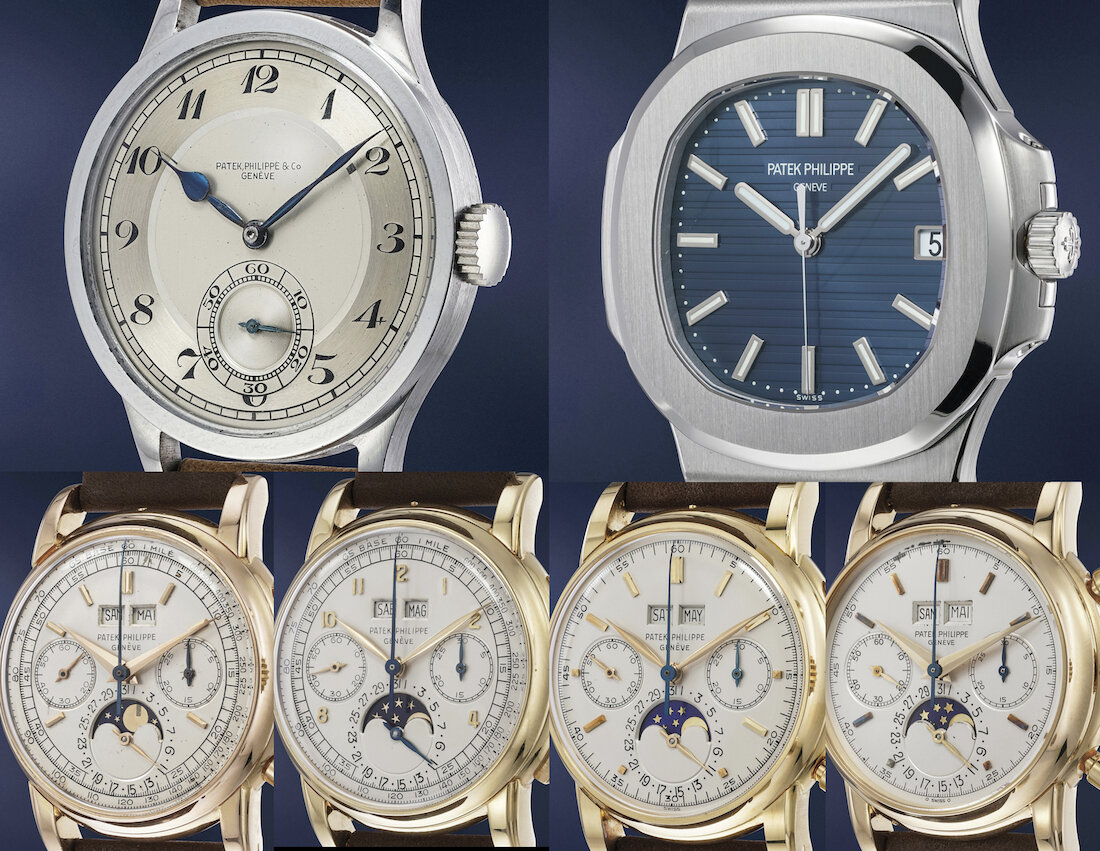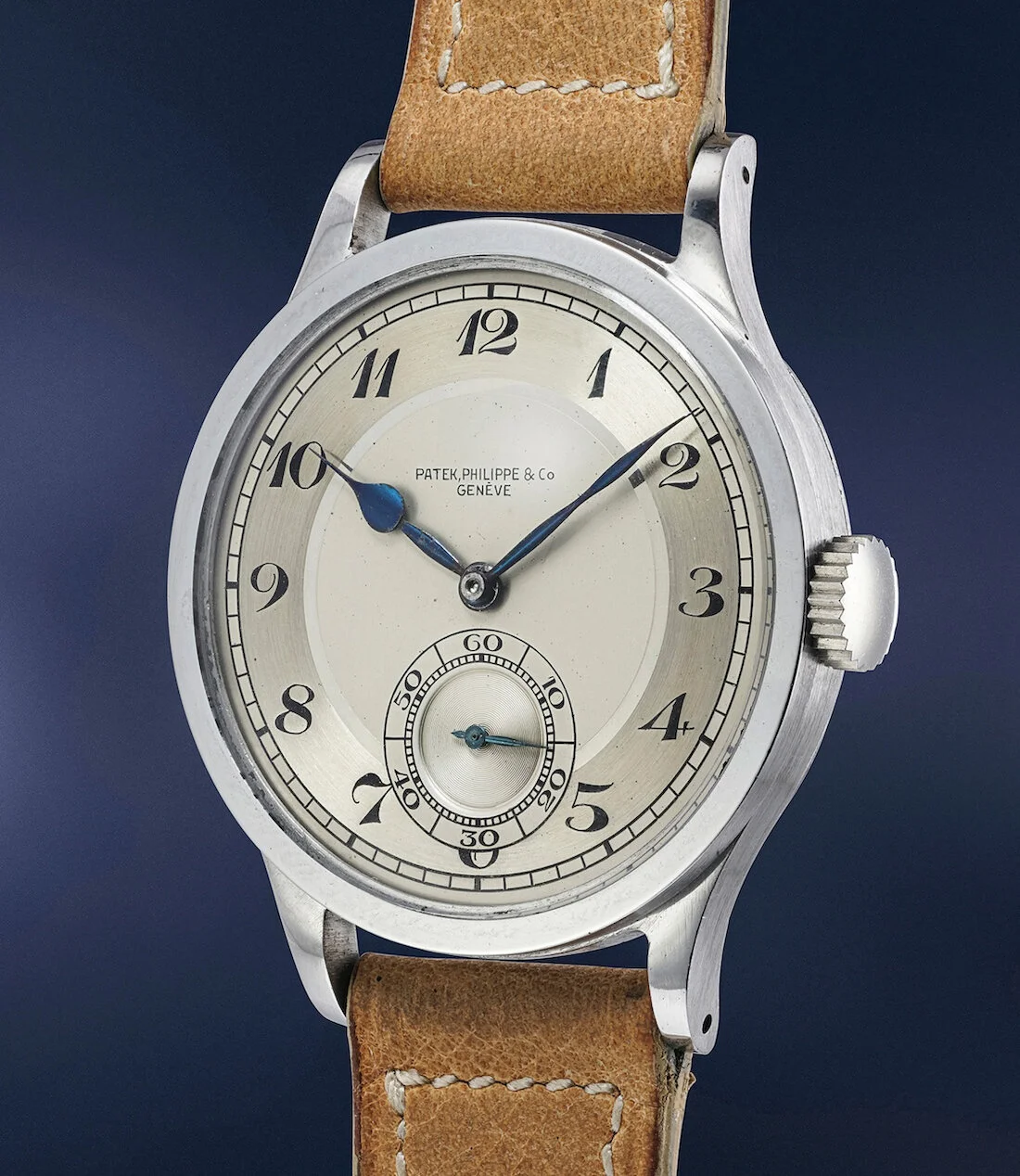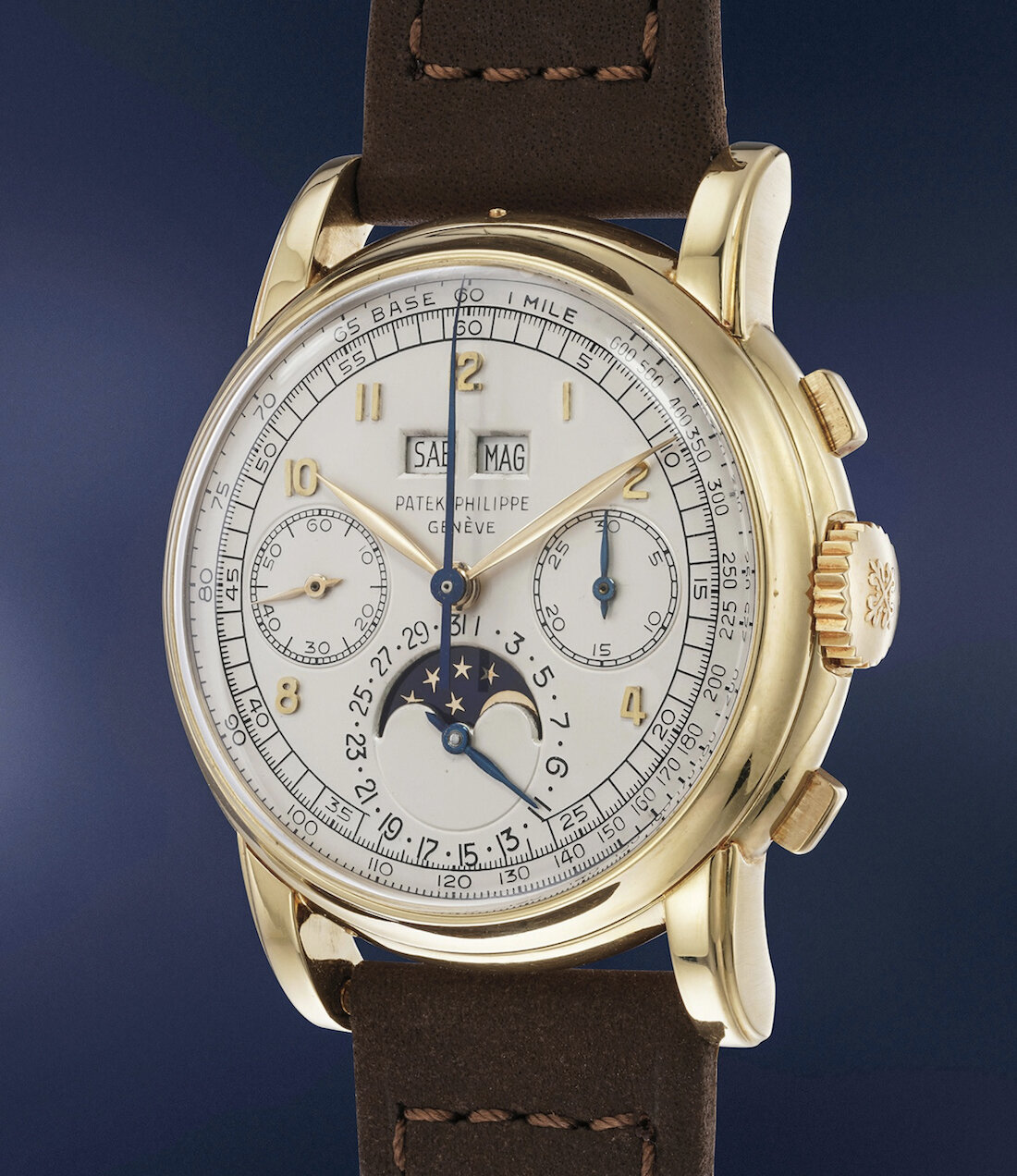This past weekend May 8-9th, 2021 in Genève, Switzerland, Phillips Watches delivered —yet again— some incredible results at their Geneva Watch Auction XIII where six Patek Philippe watches within a total of 236 lots, fetched over $10.6 Million USD. A Patek Philippe ref. 570 'Calatravone', a Nautilus ref. 5711 in Platinum and Four Different 2499s all collectively broke the $10 million USD mark in another very exciting auction under the reigns of Aurel Bacs, who we like to call ‘King Midas’.
Lot 160 - Patek Philippe ref. 570 'Calatravone'
The Patek Philippe reference 570, nicknamed ‘Calatravone’ —Italian for large Calatrava—, has been a favorite amongst collectors thanks to its large case at 37 mm, flat bezel, and vivid modernist design. Introduced in 1938, the iconic reference 570, which is a larger version of Patek Philippe’s reference 96, was manufactured with both subsidiary and center seconds configurations in stainless steel, yellow, white, and pink gold, and platinum cases.
Fresh to the auction market and one of the most impressive specimens to grace the auction market in recent years, the present reference 570 in stainless steel from 1942 features an extraordinary two-tone dial with Breguet numerals. To date, only two examples with the present dial configuration —two-tone dial with Breguet numerals and railway track— have appeared on the market, no less in such original and stunning condition. Not only is the two-tone effect dazzling and visible, but all hard enamel graphics are also present, showing that the dial has not seen intervention throughout its lifetime. As an added bonus, the dial is confirmed by the Extract from the Archives as being satin-finished with black enameled Breguet numerals, adding to the collectibility of the timepiece. The case too is in a most appealing condition with sharp facets and crisp sides. So enigmatic is this dial design that Patek Philippe chose to use this configuration in their reference 5196 in platinum.
Sold for CHF 3,297,000 Swiss Francs —approximately $3,659,670 USD.
Four Different Series of Patek Philippe ref. 2499
Every 2499 is what horological dreams are made of, for any collector. Early examples of the reference in particular, such as second or first series pieces, are considered the Olympus of collecting. When however a second series example comes dressed in pink, it can be considered the absolute apogee of high-end vintage watch collecting. The reason behind such a legendary status is multifaceted, with roots in the aesthetics of the watch as well as in its execution and production history. Reference 2499 is the second —and last vintage— serially produced perpetual calendar chronograph wristwatch with moon phases model launched by the brand. Introduced in 1950, it succeeded —and partly overlapped with— reference 1518.
So entangled is this line of timepieces with the history of the company, that it is the only line that has been in continuous production from its inception until nowadays, with five main models so far —references 1518, 2499, 3970, 5970, and 5270.
Lot 208 - Patek Philippe ref. 2499 Pink Gold Second Series
The present pink gold example belongs to the second series. Second series 37.5 mm cases are markedly different from those belonging to the first series. First and foremost, the square chronograph pushers of the first series —inherited from ref. 1518— are abandoned and in their place, we find round pushers, more modern and in tone with the then-current fashion. Scholars were hesitant on whether cases with round pushers were made exclusively by case maker Wenger. Some Vichet examples were rumored to have appeared in the past, but no consensus had been reached. In December 2019 the question was finally closed with the appearance at Phillips New York of an example with a case made by Vichet but with round pushers. The details of the dial remain the same between the first and second series —most notably, the presence of the tachymeter scale—, but second series dials are known with either Arabic or baton numerals rather than just Arabic as found in first series specimens.
Second series pieces were made, like first series examples, for about a decade between the mid-1950s and mid-1960s circa. The present 1957 specimen is one of the earliest second series made. The second series pink gold production is extremely rarified, with 8 examples with the Wenger case known from the market. Scholars agree that the total production should be at most 10 pieces. While any Patek Philippe reference 2499 is rightful to be considered a dream watch, the 18K pink gold examples are empyrean timepieces, objects which collectors spend decades striving to acquire, and often with no success. It is not just an economic problem. The innate rarity of these watches with a combined total output estimated at between 30 and 40 pieces: —about 10% of the production— coupled with the attachment collectors feel for them, mean they hardly ever appear on the market, furthermore in such attractive condition.
Without a doubt one of the best-preserved reference 2499 cases to appear on the market, the present example perfectly preserves its original proportions, and the presence of an extremely crisp hallmark to the outer side of the lugs —a highly sensitive location for a hallmark— is a telltale sign of the honesty of the piece. If that was not enough, the watch features a hardly ever seen detail: the Helvetia poinçon, gold title, and Wenger's Poinçon de Maître —number 1, inscribed into a Key— lightly stamped to the outside of the case back. This location would be very sensitive not only to polishing but to normal wear (the wrist rubbing against the back) as well. The fact that these stamps are so well preserved indicates that the watch was truly scarcely used. The dial as well is in absolutely honest condition, without a trace of restoration. A subtle ivory dial patina enhances the warmth of the pink gold case; the calendar windows present sharp edges, and all engraved and enameled graphics are absolutely present and unmolested.
An additional highly distinguished trait of this watch is the very short and transparent history of its owners. The piece remained in the same German family until its sale in 2010, and the buyers at that sale are now offering this watch making it a two-owner piece. The German heritage of the original owners perfectly matches the German calendar found on this timepiece. In fact, the present pink gold second series is the only known featuring this exotic detail. Undeniably, this watch is a true trophy that would be counted among the proudest possession of any of the most important Patek Philippe collectors worldwide.
Sold for CHF 2,450,000 Swiss Francs —approximately $2,719,500 USD.
Lot 161 - Patek Philippe ref. 2499 Yellow Gold First Series
Represented by this stupendous yellow gold example, the first series of reference 2499 is the most immediately recognizable of the four, as it features square pushers rather than the round ones seen on all other series. Two case makers have been employed for the case production. Consequently, first series cases present subtle differences according to the maker that produced them. The earliest examples feature a Vichet case, with a 36 mm diameter, flat back, and lugs more ‘claw-shaped’ and less downturned. Later examples are made by Wenger —they will make nearly all of the cases for the rest of the 2499 production until 1985— and feature a slightly larger 37.5 mm diameter, markedly downturned lugs, and a bombé case back.
Dial-wise, the first series features the same design as reference 1518. Two different varieties are known: one with the date ring enclosed by boundaries —identical to reference 1518—, and a second one where the date ring present no such delimitation. Like their ancestor, the first series dial presents a tachymeter scale and Arabic numerals. First series 2499 examples are known in yellow and pink gold and are unanimously considered to sit in the highest echelon of watch collecting. The scarcest of all series, it was in production only less than a decade, in the 1950s —though Vichet cases are not seen after 1953.
Only very few first series pieces were made, of which a handful is known in pink gold. The present example is without a doubt one of the best-preserved to ever appear at auction. The case is in stupendous condition, perfectly maintaining the lug architecture, and sporting two extremely crisp hallmarks behind the lugs. The dial is even better: only the slightest hint of off-white patina is a clue to the passage of time. Otherwise, the engraved and enameled graphics are as clear and raised as the day the dial left the workshop; even the accent on the letter “e” of Genève —a detail notoriously sensitive and often lost— is present. Made in 1953, it is one of the last first series cases made. It features an “open” date ring, as expected from a late production first series. Last seen on the public market in 2008, the present watch features an additional highly intriguing detail: the presence of an Italian calendar. Mostly featuring English or French calendar, Patek Philippe perpetual calendar watches are known to feature other languages on the dial discs as well, with Italian being extremely rare: only 4 first series yellow gold examples feature this detail.
Sold for CHF 1,966,000 Swiss Francs —approximately $2,182,260 USD.
Lot 100 - Patek Philippe ref. 2499 Yellow Gold Third Series
If one were to ask a Patek Philippe connoisseur which one is the reference that best encapsulates the ethos, savoir-faire, aesthetics and craftsmanship of the company? There are good chances that the answer will be: “Reference 2499”. It is today in the genetic code of Patek Philippe as important and relevant as, for example, the Submariner is for Rolex or the Tank for Cartier. This model has become over the years one of the ‘gold standards’ against which many —if not all— Patek Philippe complicated models are weighted. The present 1964 example is a representative of the third series of the reference. It sports an engraved and enamelled dial —as expected from an example of this era— furthermore in absolutely superb condition and an equally well-preserved case. It can be arguably considered, in terms of condition, one of the most remarkable representatives of ref. 2499. The crisp hallmark to the side of the lug matches the sharp edges. Even the tiny flat metal ring present on the bezel around the crystal features remarkable sharpness on its edge with the bezel side. An absolutely impressive, best-in-class example of this hallowed model. The dial as well is breathtaking. It is the engraved and enamelled version instead of the much easier to produce printed version introduced in the 1970s. All graphics are in perfect condition and without losses, the enamel wonderfully raised above the dial surface.
The third series remained in production for about two decades, from 1958 to circa 1978. While the case presents virtually no differences with second series cases —but was made exclusively by the case maker Wenger—, no Vichet third series are known, while Vichet examples are known from the first and second series. The dial on this example —which now sports exclusively baton numerals— presents a small modification compared to the previous series which dramatically alters the overall look and feel of the watch, the tachymeter scale is removed. This decision allowed for a much more airy design, which is in perfect accord with the predominant fashion of the 1960s and 1970s. Given the spacious, simpler dial, third series 2499 watches offer a remarkably more modern vibe than their earlier counterparts.
Notwithstanding the two decades production run, the third series of the reference 2499 presents no evolution of the dial, which is the same throughout the entire production. While slightly more swift than in earlier times, production of third series pieces still just crawled, with about 10 examples made per year. Jealously kept in the same collection for the most part of the past two decades, the present timepiece last appeared on the public market in October 2004
Sold for CHF 852,800 Swiss Francs —approximately $946,600 USD.
Lot 130 - Patek Philippe ref. 2499 Yellow Gold Fourth Series
The present fourth series Patek Philippe reference 2499 represents the very end of the production of the model, having been executed in 1985 —the year of the discontinuation of the series. With a case in superbly well-preserved condition, and a dial equally attractive and absolutely unrestored and without any loss or deterioration to the graphics, the present specimen is truly an opportunity not to be missed. The extremely few and minor hints of oxidation present on the dial are a subtle reminder of the vintage character of this treasured timepiece. Not only this watch impresses with its condition, but with its rarity as well: it is one of only six fourth series reference 2499 to bear the exotic German calendar. This particular example last appeared on the market more than 30 years ago in October 1990.
The final iteration of reference 2499 features a relatively short production run of 8 years from 1978 to 1985. However, the know-how accumulated over the previous three decades enormously improved the production process. As a result, notwithstanding its short production time, Fourth Series reference 2499 are about as numerous as third series pieces —which were in production for about 2 decades. They are exclusively known in yellow gold, even though it is speculated that a small amount was made in pink gold. The one certainty is that a Trucchi double signed third series pink gold example was upgraded into a fourth series via bezel change by Patek Philippe. While not ‘properly’ a fourth series example, that timepiece, —sold at one of the Phillips Watches auctions in 2019— sports what architecturally is a fourth series case.
While the dial layout remains generally the same as one of the third series watches, the difference with its earlier siblings resides in the crystal. The plastic crystal used so far is abandoned in favor of a modern mineral scratch-proof alternative. Such upgrade needed a minor adjustment of the bezel, which is now a bit higher. What would seem a small tweak has in fact important practical ramifications if one is to wear the watch on a regular basis.
Sold for CHF 428,400 Swiss Francs —approximately $475,500 USD.
Lot 64 - Patek Philippe Nautilus ref. 5711P in Platinum
The Patek Philippe Nautilus reference 5711 in steel was launched in 2006 to celebrate the 30th anniversary of the Nautilus. It paid tribute to its forefather, the original reference 3700, keeping the original ‘jumbo’ 42 mm case but with the addition of a central seconds hand. The 5711 immediately hit a sweet spot with collectors around the world with waiting lists going up to close to a decade until it was discontinued earlier this year 2021. However, in 2013 Patek Philippe presented a very elusive and mysterious reference 5711 in platinum. A model that was never listed in the brand’s catalog, never available for viewing, and reserved for a select clientele. It is believed that a mere 50 examples were made.
At first glance, the platinum 5711 may look like its stainless steel sibling, but subtle details set it apart, showing just how exclusive and important the watch really is. Whereas the dial of the steel watch is blue/grey, the dial of the platinum model is vivid blue contrasting beautifully with the platinum case. Other subtle details demonstrate that Patek Philippe considers this watch to be truly apart and has extra touches that add up to make all the difference, such as the logo printing on the dial. Whereas on the steel version the logo is directly printed on the fluting of the dial, with the platinum version a flat recessed area has been created for the logo print. The bevels on the case and bracelet are more prominent than on the steel version and like with all platinum Patek Philippe models a small diamond on the case at 6 o’clock indicated the use of this precious metal. Obviously however the most important element is the platinum case and bracelet that have an incredible sheen that no other metal has, the sheer heft of the watch will also remind the wearer what an incredible piece is on his or her wrist.
So rare is the platinum reference 5711 that only about 6 have graced the auction market. The present example, fresh to the auction market, is preserved in excellent condition and is delivered full set with box and paperwork. Accompanied by Patek Philippe Certificate of Origin dated November 2, 2015, leather folio, product literature, fitted box, outer packaging, and 3 extra links.
Sold for CHF 567,000 Swiss Francs —approximately $629,370 USD. For more info on Phillips Watches click here.
























